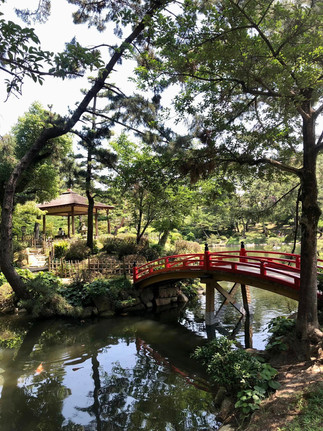Hiroshima: a visceral encounter
- Evangelia Papoutsaki
- Jun 20, 2023
- 2 min read

It was a hot day in Hiroshima but there were three places I wanted to visit before I took the ferry to Miyajima: a restored samurai’s garden, the restored Hiroshima Castle and the Hiroshima Peace Memorial. They all made me reflect on how we seek to maintain history, how restoring is an act of resilience but also how we try to create memorials for unthinkable atrocities like the atomic bombing of Hiroshima that obliterated an entire city. It felt like a city occupying the space of a ghost city, one that was but no longer is.
This brought back memories of two other cities, Budapest in Hungary and Thessaloniki in Greece whose large Jewish populations were erased in similar acts of unthinkable brutality. When I Iived in Thessaloniki in the 1980s I didn’t know that this was a largely Jewish city only just a few decades before and whose 45 thousand Jewish inhabitants were sent to concentration camps never to return. No memorial was known to me at the time that reminded us the loss of those lives but also the loss of a city that was never to be the same again. How is it possible that a city, a living organism, can loose a vital element of its body and not acknowledge it?
And then I also remembered a visit to the Jewish ghetto of Budapest in Hungary in the early 90s as part of a summer doctoral school on cultural policy at the University of Central Europe. We were tasked to describe in an ethnographic manner something of cultural significance. I found myself outside the main entrance of old building in what was an old Jewish neighborhood and looking down at that brass plaque on the cobblestones that told the passersby of the Jewish family that lived there once but no more. The sadness was overwhelming and I sat there crying for sometime. A small plaque was powerful enough to evoke the memory of an unimaginable but yet real act of brutality.
When I brought my piece back to class the facilitator described it as “lyrical” and he didn’t mean it as a compliment. What I was asked to do was to describe objectively what I saw in an impartial way, no adjectives, especially of lyrical nature were expected. I felt dismissed and didn’t attempt to write on such matters again for a long while. This professor didn’t know what visceral learning is, he was the product of a western epistemological tradition that only understands rational knowledge and meaning.
But how can anyone visit the location of an unimaginable atrocity and remain objective and analytical? The only way I could relate to such memorials or their absence is viscerally, relationally and emotionally.
Hiroshima was felt in such a way, it made itself known to me viscerally.
I COME AND STAND AT EVERY DOOR (Girl of Hiroshima) Original Turkish poem by Nazim Hikmet
I come and stand at ev'ry door, But none can hear my silent tread, I knock and yet remain unseen, For I am dead, for I am dead.
Beautifully sang by Faradouri and Livaneli: https://m.youtube.com/watch?v=bq8Bf5_Iy40...




































Comments